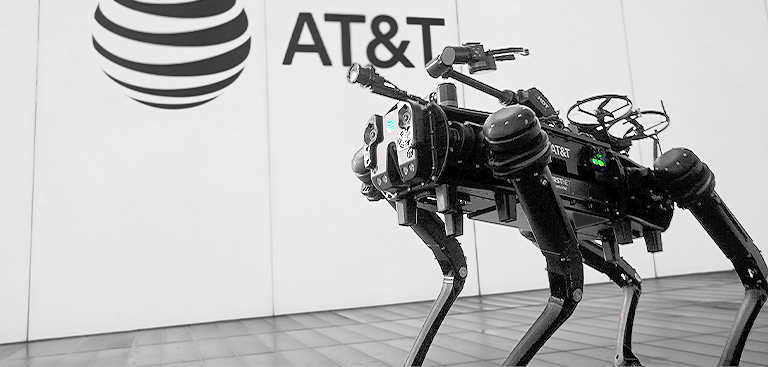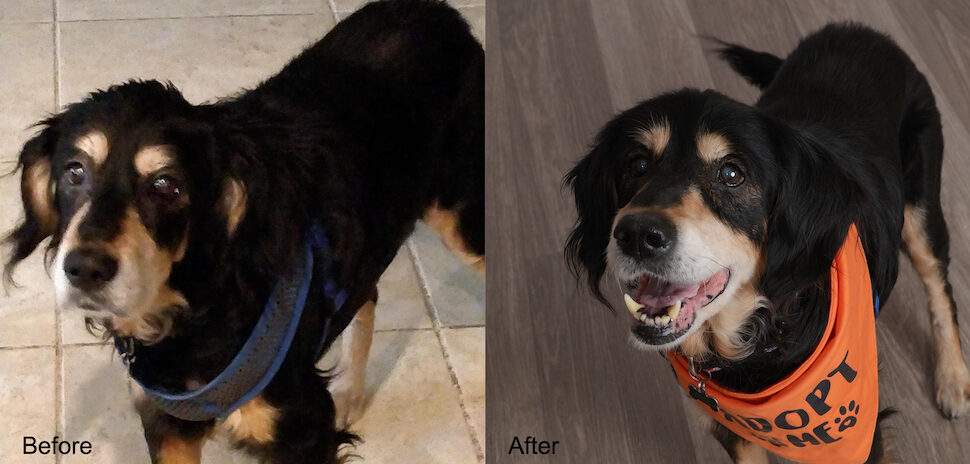They aren’t fluffy. Their cuteness level is debatable. And treats will get you nowhere. But the robotic dogs from Ghost Robotics are barking up the right tree when it comes to the needs of a wide array of potential customers.
That’s according to Dallas-based AT&T, which is collaborating with Ghost to offer “network-connected” robotic dogs for public safety, defense, federal and state agencies, local police and fire departments, and commercial customers.
Based in Philadelphia, Ghost Robotics says it’s created “robots that feel the world,” with legged robotic “ground drones” that can navigate unstructured terrain where wheeled or tracked devices fear to tread. Called Quadrupedal Unmanned Ground Vehicles, or Q-UGVs, the robotic dogs use Ghost’s proprietary “blind-mode control core,” which mimics how mammals operate across a range of urban and natural environments.
Fetching a role with FirstNet
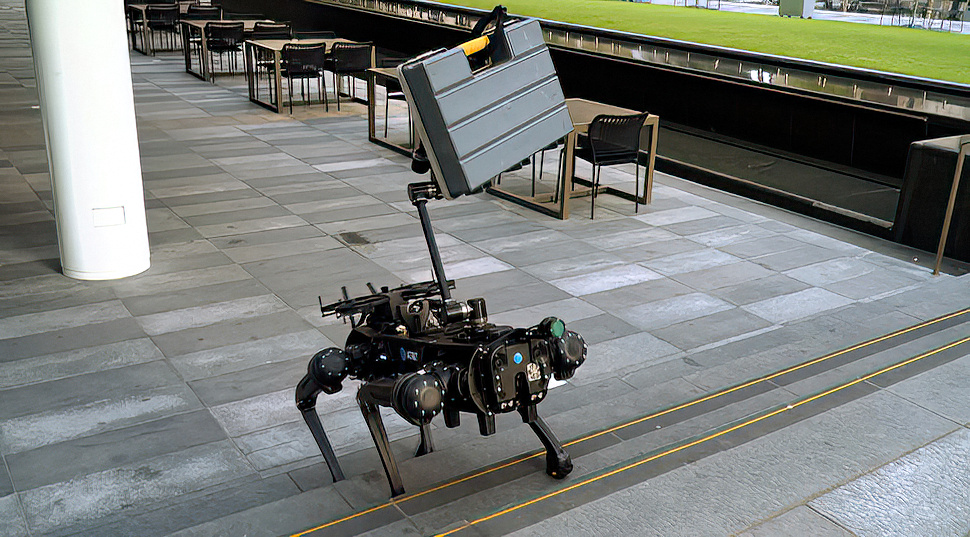
Robotic dog Payload shows off the capabilities of its articulating arm while it takes the stairs in the AT&T Discovery District. [Photo: AT&T]
In the AT&T collaboration, the robotic dogs are being put to work with FirstNet—a nationwide wireless broadband network for first responders that’s been deployed through a first-of-its-kind public-private partnership between the federal government and AT&T.
The dogs are a new breed of support for the public safety network and community.
The “first responder” robotic dogs, which operate on the FirstNet network, assist with disaster response and recovery, facility surveillance, and security operations, according to Lance Spencer, who leads defense and public safety business initiatives at AT&T.

AT&T’s robotic dog has underwater capabilities. [Photo: AT&T]
In a recent blog post, Spencer explains that the company’s robotic dogs are integrated with AT&T’s patented Geocast technology, which has received 37 patents. The robot dogs can be controlled remotely from almost anywhere on earth with this “Beyond-Visual-Line-of-Sight” operational command and control.
In addition to their remote capabilities, the robot dogs are equipped with cameras and sensors that provide operators with situational awareness and enable them to make informed decisions, he writes. These features make the robot dogs effective in a variety of situations, from emergency response to military operations.
But that’s not all—the robot dogs also have the unique ability to carry and launch drones while in motion, allowing for dramatic movie scene-like scenarios to play out in real life. The drones can then return to the robot dog’s back, making it easy to transport them to different—and difficult—locations.
And oh yes, they can swim if needed, just like a real live dog.
Former deputy sheriff is a drone pilot for AT&T’s robotic dogs program
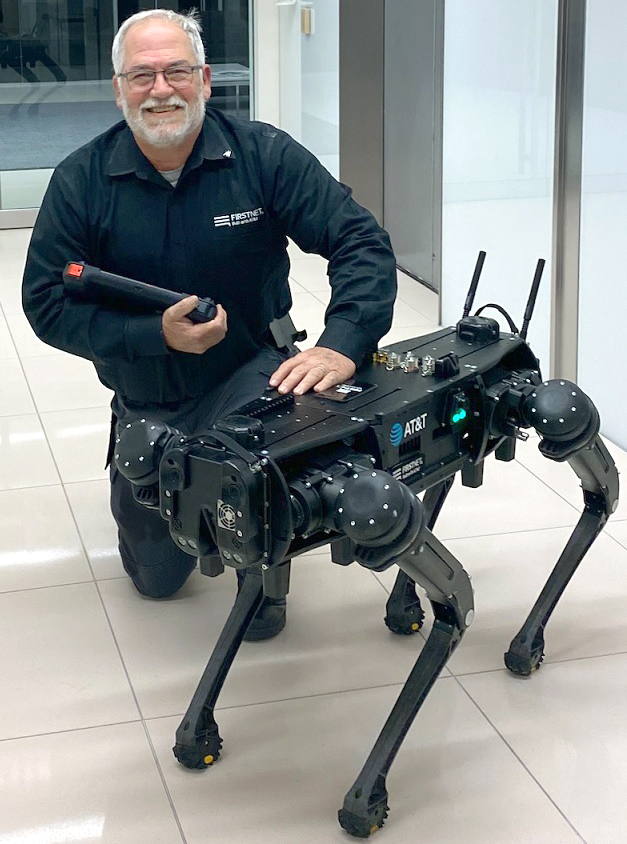
AT&T’s Allen Beadel with Payload. [Photo: AT&T]
Allen Beadel—a former deputy sheriff who’s now a North Texas-based pilot on AT&T’s Drone Operations Team—has a key role in AT&T’s robotic dogs program.
The 15-year AT&T veteran spoke with Dallas Innovates about how AT&T’s new V60 robotic dogs can help first responders, along with serving security and surveillance roles for industry, the military, and public safety.
“AT&T is always response-ready, from generators to amphibious vehicles, to trucks, trailers, drones, and robot dogs,” Beadel told us. “We even have our own hazmat response unit professionally staffed by AT&T employees.”
The robotic dogs developed by AT&T truly can be a first responder’s best friend, he said.
When they’re operated by AT&T drone pilots like Beadel, the robotic dogs can march into hard-to-reach or dangerous situations, helping to achieve heroic outcomes like locating survivors in wildfires or simply assessing damage with live, instantaneous wireless feedback.
FirstNet was created following communication breakdowns on 9/11
One time when robotic dogs could have been tremendously useful was on 9/11—an event plagued by communications breakdowns that helped motivate the development of the FirstNet network.
Now AT&T’s robotic dogs are stepping up to provide even more assistance.
Beadel says AT&T’s robotic dogs are packed with cameras, including cameras on each side and a “frog camera” on the back. The cameras provide situational awareness, enabling operators to see what’s happening in the surrounding environment. That’s especially useful when the robot dog is being operated remotely from a command post or emergency operations center located miles away, he said.
The dog is also highly adept at navigating uneven surfaces and inclines, performing more efficiently than even an athletic person could, Beadel said.
One feature making them “top dogs” in the world of emergency response technology is their speed. The dogs can move at up to seven miles per hour on flat terrain without any payload. This makes them a valuable tool for emergency responders or military personnel who need to cover ground quickly and efficiently, the drone pilot said.
Open source technology
The robotic dogs are built using open-source technology, which allows for possibilities to integrate artificial intelligence (AI) and machine learning. Although further AI integration is possible, Bedell emphasizes that these robotic dogs are not designed to act independently.
“There’s AI involved, mainly for the mobility of them at this point.” Beadel said.
The robot dogs can follow specific paths, similar to drones. “We can program [the robotic dog] to patrol a particular path or to go from waypoint to waypoint, which is a degree of autonomy, but we have to initiate it,” Beadel said
Beadell and his team work closely with AT&T’s public sector and defense teams. And as part of his work, he helps businesses envision how robotic technology can be applied to their particular needs. By showcasing the capabilities of the robotic dogs, he aims to inspire new ideas and possibilities in fields ranging from emergency response to manufacturing.
This involves spending a significant amount of time on the road with man’s best robotic friend, from demonstrations at industry events to standby at the 2023 Super Bowl.
Beadel’s cats are ‘meh’ when it comes to his robotic dog
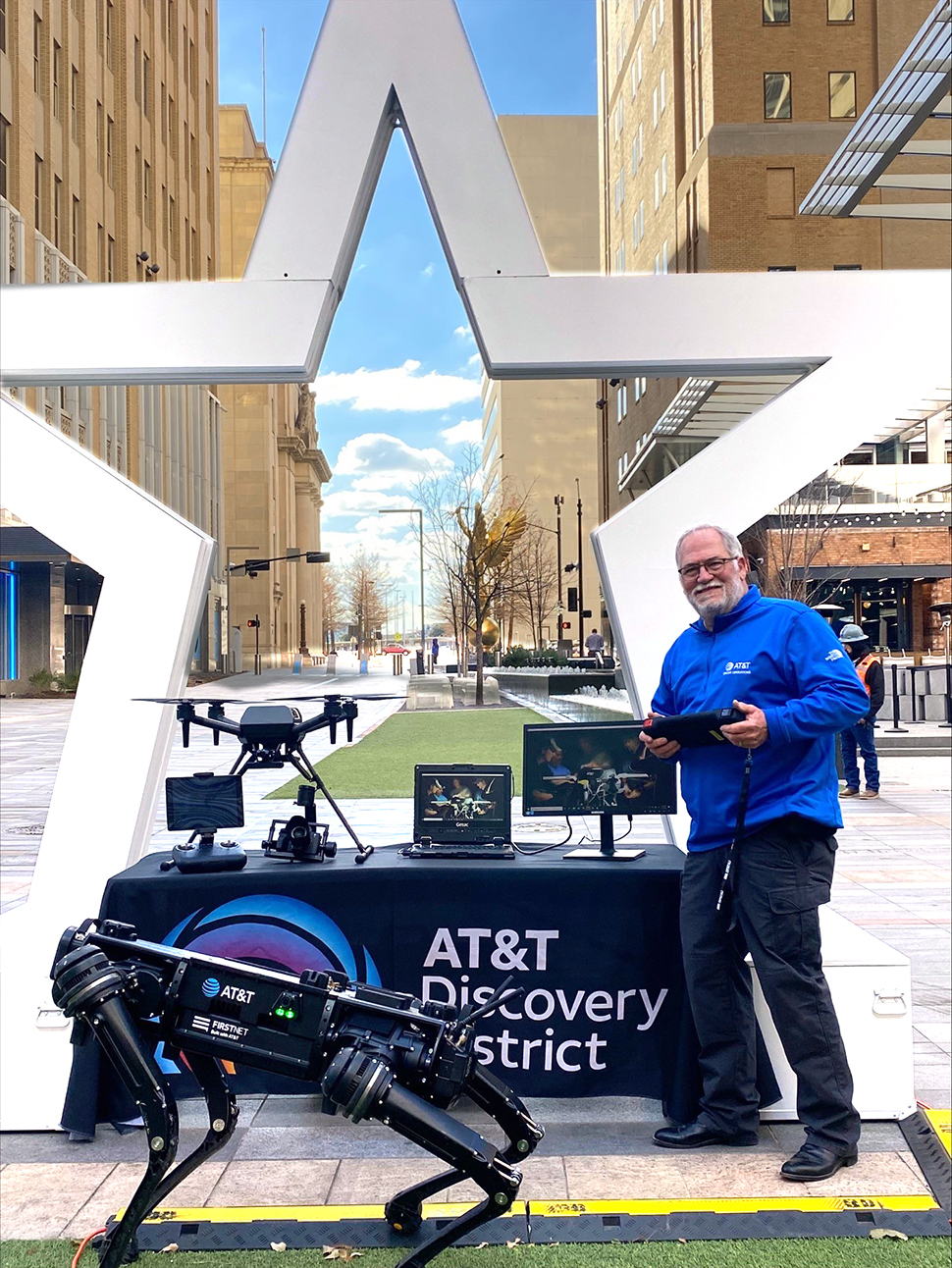
AT&T drone pilot Allen Beadel doing a demo in the downtown Dallas Discovery District. [Photo: AT&T]
So which robotic dog is Beadel closest to?
“The one that I typically tend to live with is Payload,” Beadel told us. “We have another one that’s Fido G—a play on 5G, and then my peer has one named Scout.”
Payload—nicknamed Fluffy by Beadel—is a bullet-resistant robotic dog designed to assist in various scenarios, including perimeter security, surveillance, and explosive ordnance disposal. That may sound cool, but Beadel’s cats are not impressed. They don’t like Payload. “Not even a little bit,” Beadel said.
But others do seem to like him—a lot.
‘People think the dog is cool’
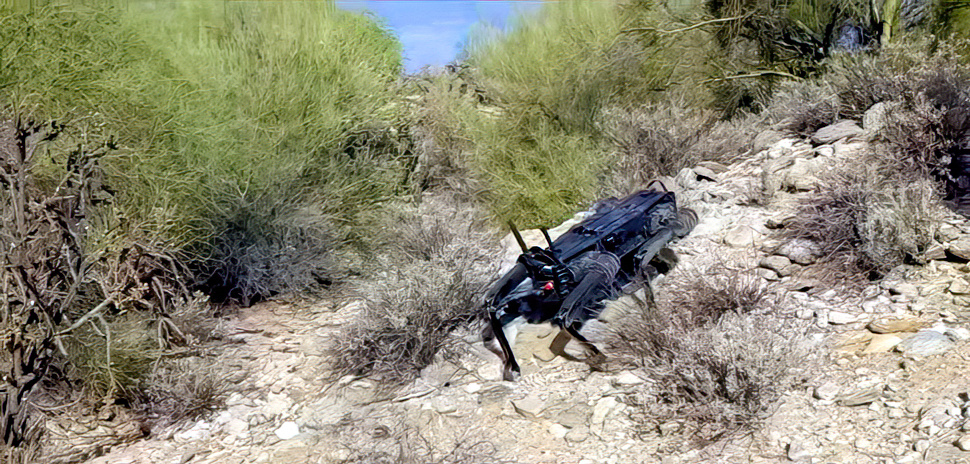
AT&T robotic dogs take challenging terrain in stride. [Photo: AT&T]
Beadel says operating the robotic dog is similar to controlling a drone, using a tablet device as a controller. The robot dogs can be programmed to follow specific paths or move from waypoint to waypoint, similar to drones.
Beadel also does demos for students in robotics and engineering classes, talking about use cases and future potential. He says students really perk up when they get to operate the dogs themselves.
“People think the dog is cool. But, you know what’s even cooler? That I get paid to operate it,” Beadel said.
From the Super Bowl to the International Spy Museum
These dogs have been getting around. Payload paraded himself near the recent Super Bowl, and Fido G strutted his stuff at the International Spy Museum in Washington D.C.
But one mission AT&T’s robotic dogs don’t have is carrying weapons. While they are bullet proof, Beadel said AT&T’s intention is not to create weaponized robots—like those often seen in science fiction movies. Instead, the company is focused on developing “practical and beneficial applications for the technology.”
The robotic dog, Beadel said, is “great as a deterrent, as a surveillance or safety tool.”
And unlike the robots from SkyNet in the “Terminator” movies, Beadel isn’t worried about what Payload and his four-legged uncrewed ground vehicle buddies could get up to.
The robotic dogs have a level of autonomy in navigation, Beadel says, but they’re always under the control of an operator. They aren’t controlled by artificial general intelligence and don’t make decisions on their own.
“The dog is not going to wake up and go out and start doing things on his own,” Beadel reassured us.
Now on patrol at an Air Force Base in Florida
AT&T’s network-connected robotic dogs are now on patrol at Tyndall Air Force Base in the Florida panhandle, among other bases.
“Our robotic dogs patrol the flight line and base perimeter at Tyndall, feeding video data in real-time to base personnel who can safely track activity 24/7/365 and support the safety of base operations,” AT&T’s Spencer wrote in the blog post. “They can perform the same task for commercial users, indoors or outdoors. For example, they can patrol the perimeters of large warehouses or outdoor fence lines.”
Spencer says the robotic dogs can also support hazmat efforts, inspect mines and high-voltage equipment, and detect explosive devices including improvised explosive devices—”all while keeping people out of harm’s way.”
Projecting a $13.4B global market for inspections by robotic dogs
Commercial applications for network-connected robotic dogs like AT&T’s are growing, Spencer added.
Utility companies are using video camera-equipped robotic dogs to inspect equipment in substations. This is a game-changer, because when humans do these inspections, operators must shut down the facilities. The robotic dogs are fine with all systems running. Allied Market Research has projected a $13.4B global market for robotic dogs performing just such inspections.
“We’ve said from the outset that the 5G journey of innovation and solution development would evolve to deliver new ways to conquer many challenges,” Spencer noted.
Now, with robotic dogs being projected to do everything from “pick and pack” jobs in warehouses to improving order fulfillment efficiency—not to mention potentially helping to save lives in a disaster—that promise is paying off.
Maybe Payload deserves a belly rub after all.
![]()
Get on the list.
Dallas Innovates, every day.
Sign up to keep your eye on what’s new and next in Dallas-Fort Worth, every day.

